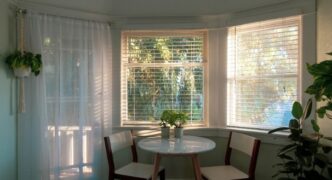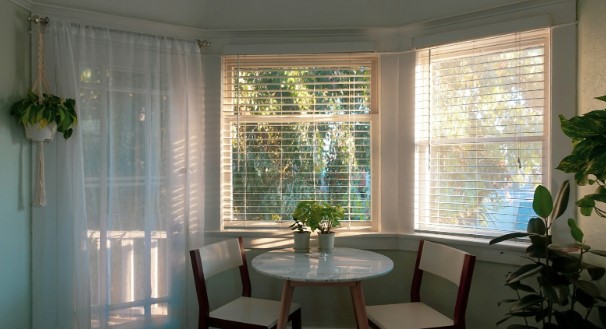Choosing the right blinds is one of those deceptively simple tasks that quickly snowball into a deep dive into materials, mechanisms, and a whole new vocabulary you weren’t prepared for. Suddenly, you’re an expert in thermal efficiency and light diffusion when all you wanted was something to block out the neighbor’s security floodlight that seems to be aimed directly at your soul. But fear not, this guide will walk you through the types of blinds available.
Roller Blinds: Sleek and Versatile
Roller blinds are the golden retrievers of the blind world. They’re friendly, reliable, and adaptable to almost any situation. Whether you need total darkness for a good sleep-in or a light filter to take the edge off the afternoon sun, there’s a roller blind to suit.
The best part is that they’re simple. A quick pull, a smooth roll, and no fiddly adjustments are required. They’re also easy to clean, which is a massive win when you realize how much dust accumulates in a house over time. If you’re after a no-fuss, modern look that just works, these are your best bet.
Venetian Blinds: The Stylish All-Rounder
If you want the ability to control light levels with precision and look effortlessly put together while doing it, Venetian blinds are the way to go. With horizontal slats that tilt at just the right angle, they give you full control over brightness, privacy, and even airflow.
Venetian blinds come in a variety of materials, from timber for that warm, sophisticated vibe to aluminum for a sleek, modern aesthetic. They do require a bit of dusting, though, but the effort is well worth it when your space looks like it belongs in an architectural magazine.
Cellular Blinds: Energy-Efficient and Sound-Absorbing
If you’re all about efficiency, cellular blinds should be considered. These clever little things have a cellular structure that traps air. This feature makes them act like a shield from the coldness of the outside world, making modern cellular blinds a must-have for anyone serious about their energy efficiency efforts.
Opting for energy saving cellular blinds translates into lower power bills and a more comfortable indoor temperature year-round. A bonus feature is that they also absorb sound. This makes them a great option if you live near a busy road or have housemates who still don’t understand the concept of using headphones.
Vertical Blinds: Practical and Affordable
Vertical blinds get a bit of an unfair reputation for being the standard office window covering, but these things are surprisingly practical. They’re ideal alternatives for large windows and sliding doors, where horizontal blinds just don’t cut it.
They’re also incredibly budget-friendly, making them a great option if you’re kitting out a whole house without wanting to eat instant noodles for the next six months. Plus, they’re much easier to clean than you’d think, with the long panels simply needing a quick wipe-down now and then.
Roman Blinds: Luxurious and Insulating
Roman blinds are for those who want their windows to look like they belong in a five-star hotel. Made from soft fabric that folds neatly as it’s raised, they bring an undeniable sense of elegance to a room. Beyond their good looks, they’re also great for insulation.
If you’re someone who appreciates a bit of grandeur but also wants to lower your energy bills, these might just be your perfect match. Just keep in mind that these blinds can be a bit high-maintenance when it comes to cleaning, as the fabric can collect dust and may require occasional spot cleaning or professional care.
Panel Glide Blinds: Modern and Space-Saving
Panel glide blinds are the secret weapon of contemporary interior design. They’re essentially a more stylish take on vertical blinds, with wide fabric panels that slide effortlessly to the side. Perfect for large windows, they create a clean, streamlined look while also being incredibly easy to use.
Panel glide blinds are essential for those who hate tangled cords and weird and clunky mechanisms. They offer smooth operation and a minimalist aesthetic that makes any space feel high-end.
Sheer Blinds: Soft and Light-Diffusing
Sheer blinds are like the Instagram filter of window coverings. They let in plenty of natural light while softening the glare, making everything look a little more dreamy and inviting.
If you love the idea of a bright, airy space but still want some privacy, these are a fantastic choice. They also pair well with blackout blinds if you want the flexibility of both light filtering during the day and total darkness at night.
Timber Blinds: Warm and Timeless
For those who appreciate a bit of natural beauty in their interiors, timber blinds are a solid investment. They add warmth, character, and a certain organic charm that’s hard to replicate with synthetic materials.
Whether stained for a rich, classic look or left in a lighter natural finish, they bring a level of sophistication that makes a room feel inviting. Just keep in mind that they don’t love moisture, so they’re better suited to living areas and bedrooms rather than bathrooms.
Aluminum Blinds: Durable and Low-Maintenance
Aluminum blinds are for the practical-minded who want something that will last without constant upkeep. They’re resistant to moisture, easy to clean, and tough enough to handle daily use without bending out of shape.
If you need a window covering that does its job without demanding attention, aluminum blinds are a solid choice. They’re particularly great for modern kitchens and bathrooms where humidity is a factor, but they can also fit well into your living room.
Zebra Blinds: Contemporary and Adjustable
Zebra blinds are the new kids on the block, offering a clever mix of sheer and opaque fabric panels that can be adjusted to control light levels. They give you the flexibility of sheer blinds with the added ability to block out light when needed.
If you like the idea of something sleek, modern, and customizable, these are worth considering. The only issue with zebra blinds is that they sometimes leave small gaps between the fabric panels, which can let in slivers of light, making them less effective for complete blackout conditions.
Conclusion
At the end of the day, the best blinds for you depend on your priorities. Luckily, there’s a style to suit every space, so take a moment to think about what you need from your window coverings before diving in. And remember, no matter what you choose, the right blinds can completely transform a room.













